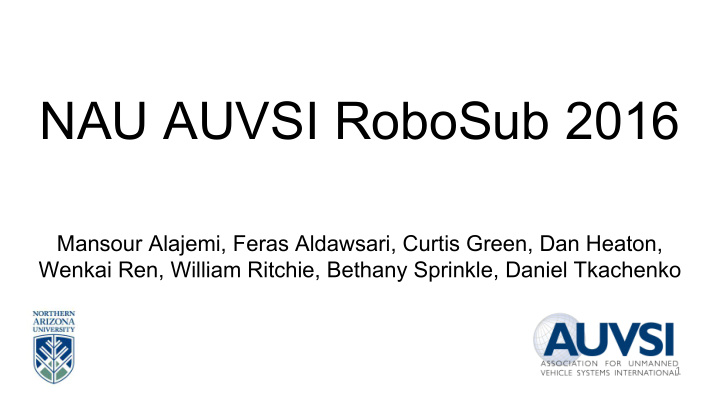



NAU AUVSI RoboSub 2016 Mansour Alajemi, Feras Aldawsari, Curtis Green, Dan Heaton, Wenkai Ren, William Ritchie, Bethany Sprinkle, Daniel Tkachenko 1
Overview Goals Concept changes Specifications Group topics 2
Goals ● Design the “Trident” autonomous underwater vehicle ● Compete in 2016 robosub competition in SD, CA. ● Test in the WAC ● Improve algorithms, electronics and mechanical design 3
Competition Tasks ● Detect path markers; orange lines ● Bump buoys in order; red then green, then drag yellow buoy downward ● Navigate through U-shaped PVC channel ● Drop markers in 1 of 2 bins ● Fire torpedos at 1 of 4 targets; various sizes ● Pickup objects near pinger and place next to associated “X” ● Surface in correct area; octagon shape 4
Competition Constraints ● Submarine must fit in a 1.83 m x 0.91 m x 0.91 m box ● Weigh less than 38 kg for no penalty ● At least 1% buoyant ● Waterproof killswitch which can engage by divers 5
Concept OLD NEW Changes: clamping, torpedo, external frame, camera window, through ports 6
Specifications ● 9.81 kg buoyant force ● 1 kilowatt of power ● 121 cm long ● 31.75 cm tall 7
Camera Box ● Front and bottom facing cameras ● Acrylic windows sealed with epoxy ● Epoxy and clamps to fasten to body 8
End Caps ● Gasket ● Aluminum end caps ● Drill holes for wires ● Secure with silicone sealant 9
Through ports ● Permanent cables sealed through endcaps with removable connectors inside ● Removable cables (red boxes) use external pvc connector caps ○ for testing purposes 18 16-gauge for motors Heat Sink 6 10-gauge for external power 8 ¼” pneumatic lines DB25 cable for communication between hulls 2 ¼” NPT for pressure sensors 3 hydrophone cables Ethernet cable for testing 10 3 wires for servo 4 16-gauge for lights
Light (Princeton Tec Attitude) ● Depth : 500 ft. ● Power 30 Lumens. ● Lamp 3 Ultrabright LEDs. ● Powered by aux board 11
Internal Frame Concept ● Modular design ○ Mix and match sections ● Fix slide for fix orientation ● Heat sinks for: ○ Electric Speed Controllers (ESCs) ○ Batteries 12
Internal Frame Assembly 13
External Frame / Brackets ● 3D printed design ● Lightweight ● Modular ○ Easy to remove/replace ● Multipurpose ○ Thrusters ○ Air tanks ○ Clasp ○ Light strip 14
Clamp / Clasp ● Powered by servo ○ Pin in slot for simplicity ● Possibly interlocking “fingers” ● Currently 3D printed ○ Considering moving to sheet/machined metal ● Can be actuated with pneumatic slide if needed ● Multi-purpose ○ Picks up lid ○ Picks up last obstacle 15
Clasp design 16
External Bracket Mounting System ● To mount thrusters ● Removable 17
Torpedo System ● Triggered by pneumatic system ● Aerodynamic shape ● Ball plungers hold the torpedo stable 18
Electronics Layout ● Modular ○ Add modules ○ Exchange modules ○ Isolate modules ● Expandable ○ I2C ○ Dynamic hardware ■ PWM or solenoid ■ Opto iso option ■ Extra ethernet ports ○ Dynamic software ■ Object Oriented programming ■ Modular programs ■ Individually testable 19
Electronics Layout Picture RPI 00 Ethernet hub RPI 01 Auxiliary board Main splitter board USB hub motor board 20
Inertial Measurement Unit(IMU) ● 9 Degrees of Freedom 9-DOF (Magnetometer, linear Acceleration, Gyro) ● For orientation of sub in water ● Complementary Filter algorithm ● Problems encountered ○ Time relative measurements drifts gyro readings ○ Movement changes downward accel readings ○ Motor flux changes magnetometer readings ○ Sensors need offsets ○ I2C line sharing and timing ○ Only will obtain rotation orientation 21
Image Detection / Processing: Line Follow Stages Steps Used: 1. Capture image 2. Apply threshold; loop through threshold parameters to adjust for light (simplify) 3. Create and apply color array mask to image 22
Image Detection / Processing: Line Follow Stages 4. Blur image to filter out excess noise 5. Apply edge detection algorithm 6. Apply Hough Line transform algorithm 7. Average lines offsets and theta 8. Send data to motor module 23
Software Completion ● Visual module ● Main abstract drive ○ 05% Fuzzy logic? ○ 00% Variable line feedback (plane ○ 05% Main linear AI block stable counter action ) ○ 30% Queued data logger with RTC ○ 30% Color and obj detection (X,Y ref) ○ 30% Variable color ability ● Multi-platform manager ● Motor module ○ 20% Queue command talk (QCT) ○ 60% Rotational PID feedback ○ 30% Locks and synchonity ○ 99% IMU feedback ○ 40% Timing ○ 40% Abstracted motor commands ● Thread managers ○ 10% Comp and user motor interface ○ 20% QCT ● Auxiliary module ○ 99% Locks ○ 80% Pressure and WD sensors data ○ 90% Timing ○ 99% Torpedo firing ○ 50% Lights on/off PWM? 24
Conclusion ● Need more development in ○ Software ○ Testing software ○ Testing mechanical prototypes ● Create simpler solutions ● Majority of design done ● Fabrication is under way 25
Recommend
More recommend